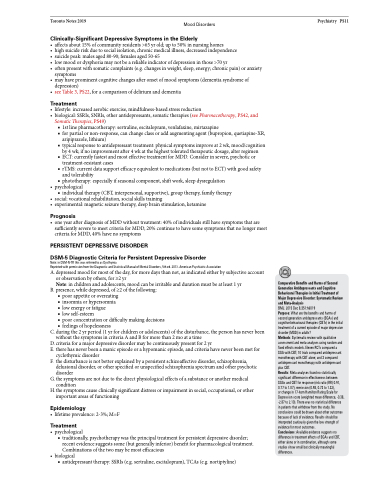Page 1175 - TNFlipTest
P. 1175
Toronto Notes 2019 Mood Disorders
Clinically-Significant Depressive Symptoms in the Elderly
• affectsabout15%ofcommunityresidents>65yrold;upto50%innursinghomes
• highsuicideriskduetosocialisolation,chronicmedicalillness,decreasedindependence
• suicidepeak:malesaged80-90;femalesaged50-65
• lowmoodordysphoriamaynotbeareliableindicatorofdepressioninthose>70yr
• oftenpresentwithsomaticcomplaints(e.g.changesinweight,sleep,energy;chronicpain)oranxiety
symptoms
• mayhaveprominentcognitivechangesafteronsetofmoodsymptoms(dementiasyndromeof
depression)
• seeTable3,PS22,foracomparisonofdeliriumanddementia
Treatment
• lifestyle:increasedaerobicexercise,mindfulness-basedstressreduction
• biological:SSRIs,SNRIs,otherantidepressants,somatictherapies(seePharmacotherapy,PS42,and
Somatic Therapies, PS49)
■ 1st line pharmacotherapy: sertraline, escitalopram, venlafaxine, mirtazapine
■ for partial or non-response, can change class or add augmenting agent (bupropion, quetiapine-XR,
aripiprazole, lithium)
■ typical response to antidepressant treatment: physical symptoms improve at 2 wk, mood/cognition
by 4 wk; if no improvement after 4 wk at the highest tolerated therapeutic dosage, alter regimen
■ ECT: currently fastest and most effective treatment for MDD. Consider in severe, psychotic or
treatment-resistant cases
■ rTMS: current data support efficacy equivalent to medications (but not to ECT) with good safety
and tolerability
■ phototherapy: especially if seasonal component, shift work, sleep dysregulation
• psychological
■ individual therapy (CBT, interpersonal, supportive), group therapy, family therapy
• social:vocationalrehabilitation,socialskillstraining
• experimental:magneticseizuretherapy,deepbrainstimulation,ketamine
Prognosis
• oneyearafterdiagnosisofMDDwithouttreatment:40%ofindividualsstillhavesymptomsthatare sufficiently severe to meet criteria for MDD, 20% continue to have some symptoms that no longer meet criteria for MDD, 40% have no symptoms
PERSISTENT DEPRESSIVE DISORDER
DSM-5 Diagnostic Criteria for Persistent Depressive Disorder
Note: in DSM-IV-TR this was referred to as Dysthymia
Reprinted with permission from the Diagnostic and Statistical Manual of Mental Disorders, 5th ed. 2013. American Psychiatric Association
A. depressed mood for most of the day, for more days than not, as indicated either by subjective account or observation by others, for ≥2 yr
Note: in children and adolescents, mood can be irritable and duration must be at least 1 yr
B. presence, while depressed, of ≥2 of the following: ■ poor appetite or overeating
■ insomnia or hypersomnia
■ low energy or fatigue
■ lowself-esteem
■ poor concentration or difficulty making decisions ■ feelings of hopelessness
C. during the 2 yr period (1 yr for children or adolescents) of the disturbance, the person has never been without the symptoms in criteria A and B for more than 2 mo at a time
D. criteria for a major depressive disorder may be continuously present for 2 yr
E. there has never been a manic episode or a hypomanic episode, and criteria have never been met for
cyclothymic disorder
F. the disturbance is not better explained by a persistent schizoaffective disorder, schizophrenia,
delusional disorder, or other specified or unspecified schizophrenia spectrum and other psychotic
disorder
G. the symptoms are not due to the direct physiological effects of a substance or another medical
condition
H.the symptoms cause clinically significant distress or impairment in social, occupational, or other
important areas of functioning
Epidemiology
• lifetimeprevalence:2-3%;M=F
Treatment
• psychological
■ traditionally, psychotherapy was the principal treatment for persistent depressive disorder;
recent evidence suggests some (but generally inferior) benefit for pharmacological treatment.
Combinations of the two may be most efficacious • biological
Psychiatry PS11
■ antidepressant therapy: SSRIs (e.g. sertraline, escitalopram), TCAs (e.g. nortiptyline)
Comparative Benefits and Harms of Second Generation Antidepressants and Cognitive Behavioural Therapies in Initial Treatment of Major Depressive Disorder: Systematic Review and Meta-Analysis
BMJ. 2015 Dec 8;351:h6019
Purpose: What are the benefits and harms of second generation antidepressants (SGAs) and cognitive behavioural therapies (CBTs) in the initial treatment of a current episode of major depressive disorder (MDD) in adults?
Methods: Systematic review with qualitative assessment and meta-analyses using random and fixed effects models. Eleven RCTs compared a
SGA with CBT; 10 trials compared antidepressant monotherapy with CBT alone; and 3 compared antidepressant monotherapy with antidepressant plus CBT.
Results: Meta-analyses found no statistically significant difference in effectiveness between SGAs and CBT for response (risk ratio (RR) 0.91, 0.77 to 1.07), remission (0.98, 0.73 to 1.32),
or change in 17-item Hamilton Rating Scale for Depression score (weighted mean difference, -0.38, -2.87 to 2.10). There was no statistical difference in patients that withdrew from the study. No conclusions could be drawn about other outcomes because of lack of evidence. Results should be interpreted cautiously given the low strength of evidence for most outcomes.
Conclusions: Available evidence suggests no difference in treatment effects of SGAs and CBT, either alone or in combination, although some studies show small but clinically meaningful differences.


